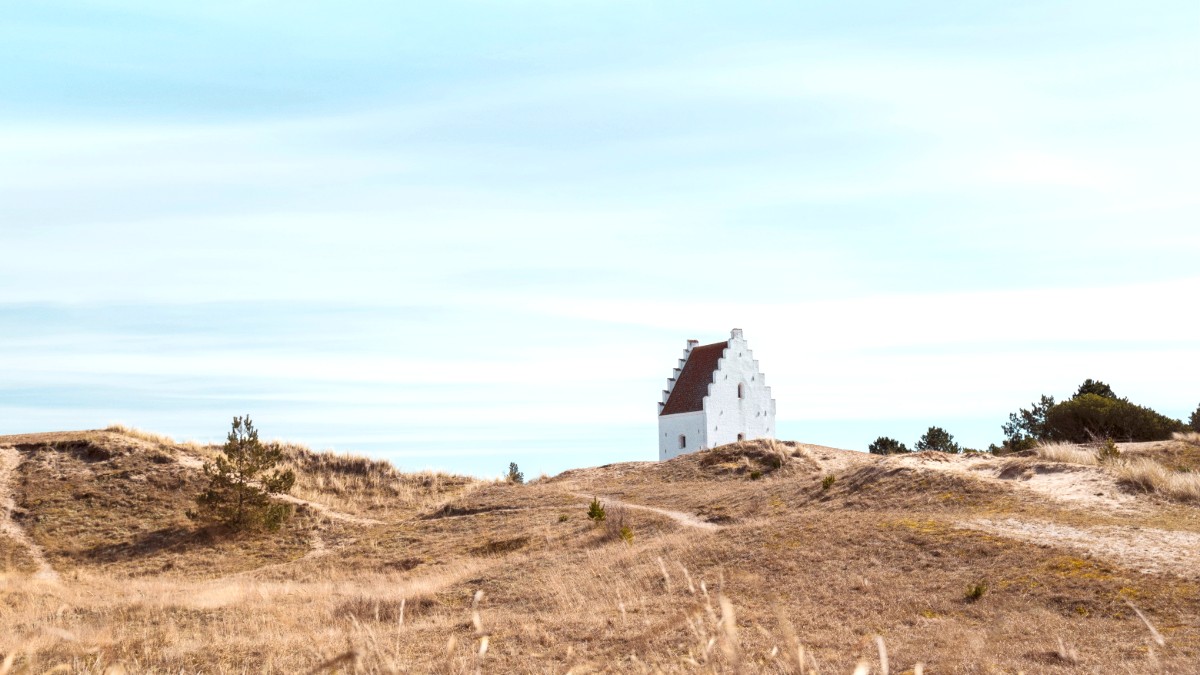
Jutland, Denmark
Skagen's most famous landmarks display its unique geography and enduring struggle with nature.
Grenen is the northernmost tip of Denmark, a narrow sand spit where the waters of the Skagerrak (North Sea) and the Kattegat (Baltic Sea) converge. You can literally stand with one foot in each sea, observing the visible currents clash. It is a powerful natural phenomenon, shaped by the constant movement of sand and water.
Climb 210 steps to the top for breathtaking panoramic views of Skagen, Grenen, and the coastline. This perspective clarifies the area's geography. A prime spot for birdwatching during migration seasons.
Early morning, late evening, or during shoulder seasons (spring/autumn) offer a more peaceful experience at Grenen.
Be aware of parking fees for vehicles when visiting Grenen. These can vary by season.
The tractor-bus provides a convenient ride for those preferring not to walk the sandy stretch to the tip.
Strong currents at Grenen pose a significant hazard; swimming is not safe.
Capture the unique meeting of two seas, especially during optimal lighting hours.
Skagen's artistic legacy finds good preservation and celebration in its numerous museums and cultural spaces.
Dedicated to the famous Skagen Painters, displaying their iconic works and offering insight into the artists' colony. Houses pieces by P.S. Krøyer, Michael Ancher, Anna Ancher.
The former home and studio of artists Michael and Anna Ancher, preserved as it was when they lived there. It presents a deeply personal glimpse into their lives and artistic processes.
The home of poet and painter Holger Drachmann, another important member of the Skagen artistic community. His house illuminates his life, work, and Skagen connection.
Focuses on Skagen's maritime history, fishing industry, and lifeboat service. It includes an open-air museum section with historic buildings, displaying daily life of a fishing community.
A preserved German bunker from WWII, it offers insight into coastal defenses built during the occupation. It presents a sobering view of a different aspect of Skagen's history.
Opening hours vary seasonally; check official websites. Admission fees apply. Combined tickets for Skagen Museum and Anchers Hus are often available.
At Skagen Museum, search for Krøyer's "Summer Evening at Skagen's Southern Beach" and Ancher's "A Funeral."
See original furnishings, personal belongings, and many works displayed in their living and working spaces. It is an unique connection to the artists.
Book tickets for attractions and tours via GetYourGuide.
Beyond the museums, Skagen's history shows itself through its working harbor and charming town streets.
Skagen Harbor, inaugurated in 1907, remains a lively hub of activity. It is Denmark's largest fishing port by value of landed fish.
The town itself is a historical site, with its charming streets and distinctive yellow houses. These buildings are a hallmark of Skagen's architectural heritage.
Skagen's natural beauty stretches beyond Grenen, presenting diverse landscapes for exploration.
Beyond the main attractions, Skagen holds smaller, lesser-known spots that present unique insights and experiences.
To maximize your exploration of Skagen's landmarks and attractions, consider grouping nearby sites together for an efficient day of discovery.
Public transport options are available, but walking and cycling remain popular ways to navigate the town and its natural areas. Many sites are within close proximity.
Map out your route to visit Grenen, Skagen Lighthouse, and the Buried Church, as they are relatively close to each other.
Allocate time for Skagen Museum and Anchers Hus, possibly with a combined ticket for convenience.
Plan a dedicated trip to Råbjerg Mile for a distinct natural experience, often taking half a day.
The local tourist information office (VisitSkagen) can provide maps, brochures, and up-to-date information on opening hours and events.
Book tours on GetYourGuideBicycles are a popular mode of transport, with rental shops available. The town center is walkable.
Some attractions, specifically smaller museums or special exhibitions, may have reduced hours or close during the low season (winter).
Look for combined tickets for multiple museums or attractions to potentially save on admission costs.
The unique light in Skagen, notably around sunrise and sunset, renders beautiful photographic opportunities at Grenen and the beaches.
Skagen's museums offer diverse insights into art, history, and maritime life.
Exploring Skagen's natural wonders promises unique and beautiful experiences.
Engaging with local guides can enrich your visit to historical sites by providing historical context and personal stories.
Many smaller galleries and artisan workshops welcome visitors to observe artists at work. This offers an unique cultural experience.
Skagen's charm extends beyond its most visited spots. Discover these areas for a different perspective and a connection to the region.
This natural area southwest of Skagen features large, erratic boulders deposited during the Ice Age. These ancient stones establish an unique, almost mystical landscape.
While many visitors focus on the main town, exploring the quiet, charming streets of Old Skagen (Højen) presents a glimpse into the historic artists' community without the main tourist crowds.
Beyond the main museums, many local artists maintain studios and galleries throughout Skagen. Visitors can find unique artworks, ceramics, jewelry, and textiles inspired by Skagen's light and landscape.
These smaller galleries present a genuine connection to Skagen's contemporary art scene.
Explore the plantations and wooded areas surrounding Skagen for quiet walks and cycling trails. These planted forests stabilize sandy soil.
These areas are often less crowded, delivering a tranquil escape.
Look for various plaques and small monuments scattered throughout Skagen. These tell stories of historical events or noteworthy figures related to the town.
These discrete markers are rewarding discoveries for history buffs.
Beyond Det Grå Fyr, find the older Skagen Lighthouse (Den Gamle Fyr), which is now an exhibition space and viewpoint.
The Skagen Fuglestation at Det Grå Fyr conducts bird ringing activities. Observing this work can be fascinating for nature enthusiasts.
Skagen's public library often hosts local exhibitions or lectures on regional history and art, which can be interesting for a dive.